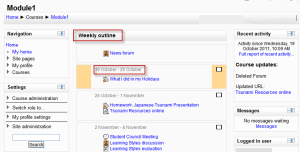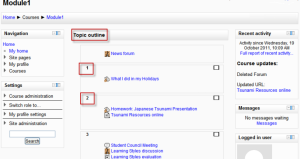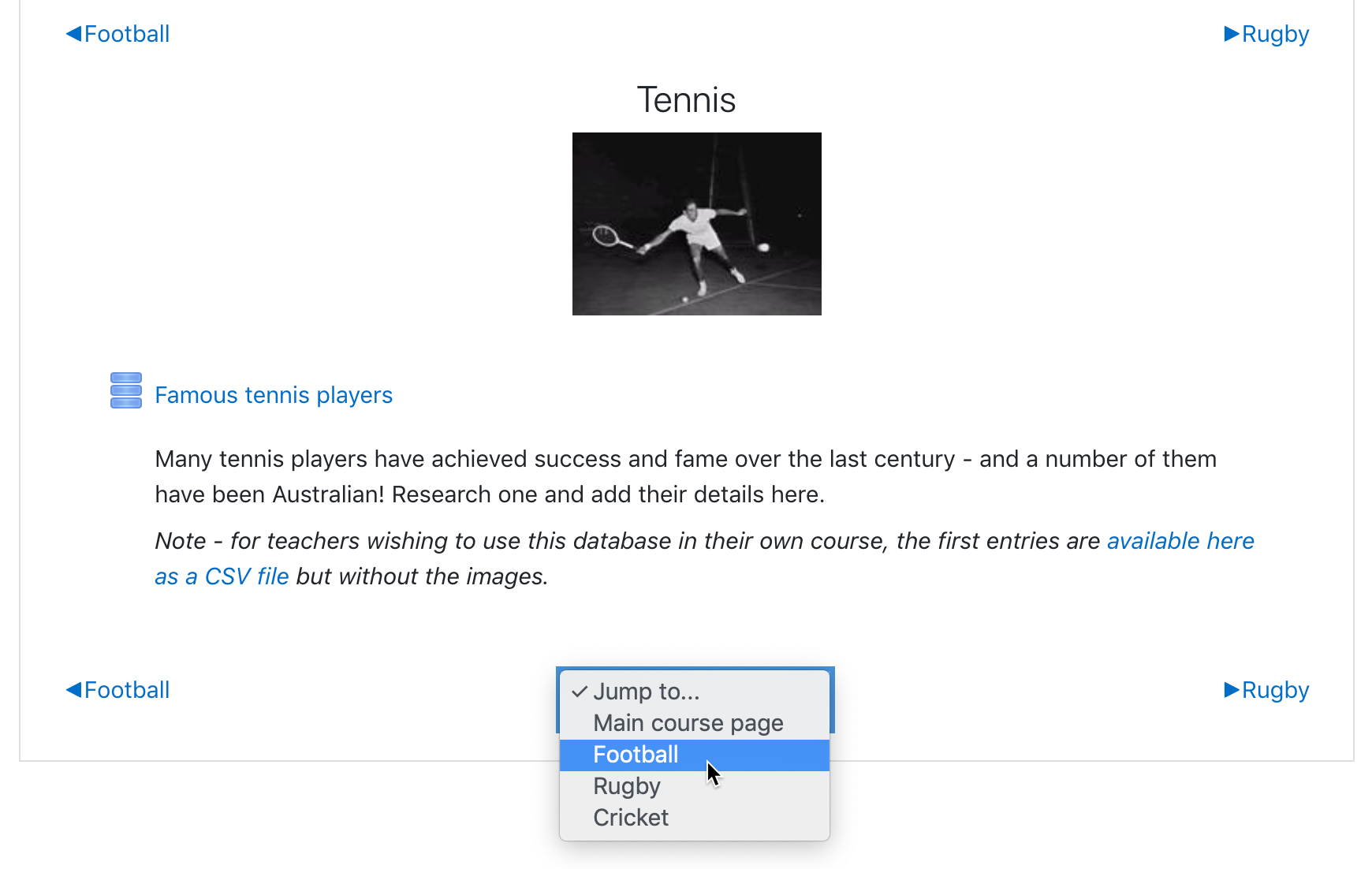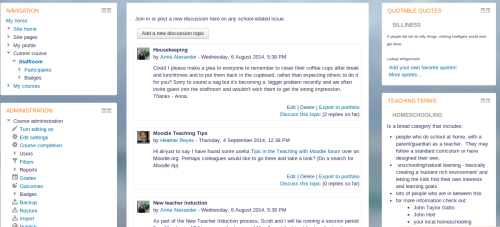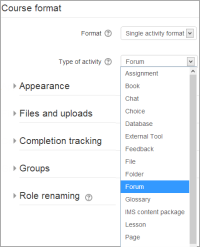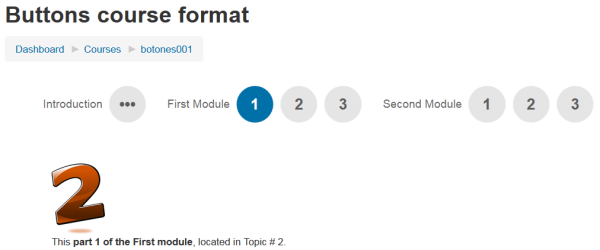Course formats: Difference between revisions
(→See also: Adding MoodleBites YouTube video link) |
Helen Foster (talk | contribs) m (→Social format: removing broken link) |
||
| (21 intermediate revisions by 6 users not shown) | |||
| Line 5: | Line 5: | ||
{| | {| | ||
|[[File: | |[[File:DefaultCourseFormatTopics.png|thumb|Manage course formats screen for admins]] | ||
|} | |} | ||
| Line 11: | Line 11: | ||
===Weekly format=== | ===Weekly format=== | ||
[[Image:Weeklyoutline.png|thumb|Weekly format example]] The course is organized week by week, with a | [[Image:Weeklyoutline.png|thumb|Weekly format example]] The course is organized week by week, with each section having a date heading. Moodle will create a section for each week of your course. You can add content, forums, quizzes, and so on in the section for each week. The current week is highlighted. | ||
:''TIP:'' If you want all your students to work on the same materials at the same time, this would be a good format to choose. | :''TIP:'' If you want all your students to work on the same materials at the same time, this would be a good format to choose. | ||
:''NOTE:'' Make sure your course start date is correct. If it is not your weeks will have the wrong date on it. This is especially important if you are restoring a course to use with a new section of students. | :''NOTE:'' Make sure your course start date is correct. If it is not your weeks will have the wrong date on it. This is especially important if you are restoring a course to use with a new section of students. | ||
If you have students starting the course at different times, you can use the feature [[Course relative dates]] to display dates for each course section relative to the student's start date in the course. | |||
===Topics format=== | ===Topics format=== | ||
[[Image:Topicoutline.png|thumb|Topic format example]]The course is organised into topic sections that a teacher can give titles to. Each topic section consists of activities, resources and labels. | [[Image:Topicoutline.png|thumb|Topic format example]]The course is organised into topic sections that a teacher can give titles to. Each topic section consists of activities, resources and labels. In new installations of Moodle, this is the default format. | ||
TIP: This is great to use if your course is objective based and each objective may take different amounts of time to complete. An example of this would be scaffolding where the students are building upon the knowledge from earlier topics. | TIP: This is great to use if your course is objective based and each objective may take different amounts of time to complete. An example of this would be scaffolding where the students are building upon the knowledge from earlier topics. | ||
| Line 29: | Line 31: | ||
''Notes:'' | ''Notes:'' | ||
*The course home page shows just the section names and any text in the section description along with activity and resource numbers, with the names being click-able. | *The course home page shows just the section names and any text in the section description along with activity and resource numbers, with the names being click-able. This is what you see the first time you access the course. Once you have selected a topic by clicking on its name, you then see one section at a time. | ||
*If editing is ON, then the Main course page will display all the content in all the sections. | *If editing is ON, then the Main course page will display all the content in all the sections. | ||
*There is a 'Jump to...' menu at the bottom of each single section page | *There is a 'Jump to...' menu at the bottom of each single section page | ||
===Social format=== | ===Social format=== | ||
This format is oriented around one main [[Forum module|forum]],the social forum, which appears listed on the main page. It is useful for situations that are more free form. They may not even be courses. | |||
[[Image:SocialFormatN.png|thumb|center|500px|Social format example - click to enlarge]] | |||
When selecting the social format, it is possible to specify how many discussions you wish to display on the course page: | |||
The social forum can be edited by clicking the 'Update this forum' button on the social forum page. The forum introduction is displayed at the top of the course page. Activities and resources can be added on side | [[File:socialformatdiscussions.png]] | ||
The social forum can be edited by clicking the 'Update this forum' button on the social forum page. The forum introduction is displayed at the top of the course page. Activities and resources can be added on the side by using the [[Social activities block]]. | |||
===Single activity format=== | ===Single activity format=== | ||
| Line 53: | Line 61: | ||
See MDL-27646 and MDL-28555 and maybe the discussion http://moodle.org/mod/forum/discuss.php?d=175758#p770737 | See MDL-27646 and MDL-28555 and maybe the discussion http://moodle.org/mod/forum/discuss.php?d=175758#p770737 | ||
===Buttons course format=== | |||
The Buttons course format creates a menu with buttons in JavaScript to access the sections, one by one. It has features to create group of sections (example: modules, period) and change the button colors. For more information, please visit [[Buttons course format]]. | |||
[[File:Buttons course format 9 buttons section 2.png|600px]] | |||
===Collapsed Topics=== | ===Collapsed Topics=== | ||
| Line 62: | Line 76: | ||
For an overview of 'Collapsed Topics' please see this video: | For an overview of 'Collapsed Topics' please see this video: | ||
{{MediaPlayer | url = https://www.youtube.com/watch?v=c9NaEAPPC5E}} | |||
===Daily format=== | ===Daily format=== | ||
| Line 68: | Line 82: | ||
===Grid format=== | ===Grid format=== | ||
The [ | The [[Grid course format]] is a modular and visual course format. Hides all topics and creates a grid of icons (one for each topic) with short titles. Clicking on an icon brings up the content from the corresponding topic in a "lightbox" style display. | ||
===Menutopic format=== | ===Menutopic format=== | ||
| Line 78: | Line 92: | ||
===Onetopic format=== | ===Onetopic format=== | ||
The [https://moodle.org/plugins/view.php?plugin=format_onetopic onetopic format] shows each topic in a tab, keeping the current tab between calls to resources, in such a way that when it returns from a module as the blog or the glossary it returns to tab from where you started. This format is based on the Moodle standard format: “Topics”. | The [https://moodle.org/plugins/view.php?plugin=format_onetopic onetopic format] shows each topic in a tab, keeping the current tab between calls to resources, in such a way that when it returns from a module as the blog or the glossary it returns to tab from where you started. This format is based on the Moodle standard format: “Topics”. | ||
===Tiles format=== | |||
The [https://moodle.org/plugins/view.php?plugin=format_tiles tiles format] displays course topics as "Tiles", rather than as a list. When clicked, tile content is displayed under the tile with an animated transition. The layout adapts to different screen sizes and orientations. Within each tile, activities can also be set to display as "sub-tiles". Icons for each tile can be selected from a predefined set (i.e. the teacher does not need to upload them). | |||
===Topic format (colors)=== | ===Topic format (colors)=== | ||
| Line 84: | Line 101: | ||
===Flexible sections format=== | ===Flexible sections format=== | ||
The [https://moodle.org/plugins/view.php?plugin=format_flexsections flexible sections format] for Moodle 2.4+ allows to have nested sections and each section may be displayed expanded (with all content on the parent section page) or collapsed (as a link to a separate page) | The [https://moodle.org/plugins/view.php?plugin=format_flexsections flexible sections format] for Moodle 2.4+ allows to have nested sections and each section may be displayed expanded (with all content on the parent section page) or collapsed (as a link to a separate page) | ||
===Kickstart format (Course Wizard)=== | |||
The [https://moodle.org/plugins/format_kickstart kickstart course format] is a special course format which helps teachers to create courses. Instead of the empty skeleton teachers usually find (and sometimes even students), this course format provides up to three course templates to make creating a course a lot easier. | |||
Documentation can be found [https://docs.moodle.org/37/en/Kickstart_course_format here] | |||
Other contributed course formats are available from the [http://moodle.org/plugins modules and plugins database]. | Other contributed course formats are available from the [http://moodle.org/plugins modules and plugins database]. | ||
==See also== | ==See also== | ||
*Screencast: [http://www.youtube.com/watch?v=bkdgPGHJi3Q&feature=share&list=SPxcO_MFWQBDe8RRnGjoUDqbcm9PSlIoWn&index=2 Single Activity course format] | *Screencast: [http://www.youtube.com/watch?v=bkdgPGHJi3Q&feature=share&list=SPxcO_MFWQBDe8RRnGjoUDqbcm9PSlIoWn&index=2 Single Activity course format] | ||
*Example of a single activity course format on | *Example of a single activity course format on the School demo site: [http://school.moodledemo.net/mod/quiz/view.php?id=1511 Moodle History Quiz] (Log in with username: ''parent'' and password: ''moodle'') | ||
*Using Moodle [http://moodle.org/mod/forum/view.php?id=47 Course formats forum] | *Using Moodle [http://moodle.org/mod/forum/view.php?id=47 Course formats forum] | ||
Using Moodle forum discussions: | Using Moodle forum discussions: | ||
*[http://moodle.org/mod/forum/discuss.php?d=116428 Social format: where to put an introduction] | *[http://moodle.org/mod/forum/discuss.php?d=116428 Social format: where to put an introduction] | ||
*[http://moodle.org/mod/forum/discuss.php?d=136453 RSS Feed for forum in a Social Format course] | *[http://moodle.org/mod/forum/discuss.php?d=136453 RSS Feed for forum in a Social Format course] | ||
[[Category:Course format]] | |||
[[de:Kursformate]] | [[de:Kursformate]] | ||
[[es:Formatos de curso]] | [[es:Formatos de curso]] | ||
[[fr:Formats de cours]] | [[fr:Formats de cours]] | ||
Latest revision as of 17:11, 22 February 2021
A course format refers to the layout of a course. The course format can be selected in Administration > Course administration > Edit settings.
An administrator can enable, disable or delete course formats for courses in Administration > Site administration > Plugins > Course formats > Manage course formats. They can also change the order in which available course formats are displayed to teachers in the course settings.
Standard course formats
Weekly format
The course is organized week by week, with each section having a date heading. Moodle will create a section for each week of your course. You can add content, forums, quizzes, and so on in the section for each week. The current week is highlighted.
- TIP: If you want all your students to work on the same materials at the same time, this would be a good format to choose.
- NOTE: Make sure your course start date is correct. If it is not your weeks will have the wrong date on it. This is especially important if you are restoring a course to use with a new section of students.
If you have students starting the course at different times, you can use the feature Course relative dates to display dates for each course section relative to the student's start date in the course.
Topics format
The course is organised into topic sections that a teacher can give titles to. Each topic section consists of activities, resources and labels. In new installations of Moodle, this is the default format.
TIP: This is great to use if your course is objective based and each objective may take different amounts of time to complete. An example of this would be scaffolding where the students are building upon the knowledge from earlier topics.
"Show only one section"
With the Weekly, Topics and any contributed format that implements the functionalty, it is possible via Administration > Course administration > Edit settings to "show one section per page". Here is a course with eight topics, with the third one currently shown. The links left and right lead to topics two and four:
Notes:
- The course home page shows just the section names and any text in the section description along with activity and resource numbers, with the names being click-able. This is what you see the first time you access the course. Once you have selected a topic by clicking on its name, you then see one section at a time.
- If editing is ON, then the Main course page will display all the content in all the sections.
- There is a 'Jump to...' menu at the bottom of each single section page
Social format
This format is oriented around one main forum,the social forum, which appears listed on the main page. It is useful for situations that are more free form. They may not even be courses.
When selecting the social format, it is possible to specify how many discussions you wish to display on the course page:
The social forum can be edited by clicking the 'Update this forum' button on the social forum page. The forum introduction is displayed at the top of the course page. Activities and resources can be added on the side by using the Social activities block.
Single activity format
The single activity format only has 1 section, and allows the teacher to add one activity only to the course. When the single activity format is selected, a drop down menu appears for the teacher to choose the activity they wish to use. See the "See also" section below for a screencast and working example of the single activity course format.
Note: This course format replaces the SCORM format in earlier versions of Moodle, as it is possible here to select a SCORM package as the single activity.
Single activity format with a forum as the activity and social format are very similar. The only difference is when the course contains other activities. The single activity format displays them as "orphaned" and for teachers only; the social format displays them in an activities block and available for students.
Contributed Course Formats
The Moodle community has developed a number of course formats, available in the plugins directory. If you plan to create a new one, see Developers documentation.
See MDL-27646 and MDL-28555 and maybe the discussion http://moodle.org/mod/forum/discuss.php?d=175758#p770737
Buttons course format
The Buttons course format creates a menu with buttons in JavaScript to access the sections, one by one. It has features to create group of sections (example: modules, period) and change the button colors. For more information, please visit Buttons course format.
Collapsed Topics
This is a format that is essentially the same as the standard Topic and Weekly formats but with a 'toggle' for each section except '0'. The toggles' purpose is to reduce the amount of initial information presented to the user thus reducing the 'scroll of death' that can plague courses with a lot of content. The 'state' of the toggles is remembered on a per course per user basis. For more information, please visit Collapsed_Topics_course_format.
Overview
For an overview of 'Collapsed Topics' please see this video:
Daily format
The daily format is a modification of the weekly format that shows sections by day rather than by week.
Grid format
The Grid course format is a modular and visual course format. Hides all topics and creates a grid of icons (one for each topic) with short titles. Clicking on an icon brings up the content from the corresponding topic in a "lightbox" style display.
Menutopic format
The menutopic format allows you to display the topics/sections in a menu.
Noticeboard format
The Noticeboard format presents the latest post in the news forum at the top of the course.
Onetopic format
The onetopic format shows each topic in a tab, keeping the current tab between calls to resources, in such a way that when it returns from a module as the blog or the glossary it returns to tab from where you started. This format is based on the Moodle standard format: “Topics”.
Tiles format
The tiles format displays course topics as "Tiles", rather than as a list. When clicked, tile content is displayed under the tile with an animated transition. The layout adapts to different screen sizes and orientations. Within each tile, activities can also be set to display as "sub-tiles". Icons for each tile can be selected from a predefined set (i.e. the teacher does not need to upload them).
Topic format (colors)
The colored topic format is based on the 'Topics' standard format and allows a teacher to specify the foreground and background colours for each course section.
Flexible sections format
The flexible sections format for Moodle 2.4+ allows to have nested sections and each section may be displayed expanded (with all content on the parent section page) or collapsed (as a link to a separate page)
Kickstart format (Course Wizard)
The kickstart course format is a special course format which helps teachers to create courses. Instead of the empty skeleton teachers usually find (and sometimes even students), this course format provides up to three course templates to make creating a course a lot easier. Documentation can be found here
Other contributed course formats are available from the modules and plugins database.
See also
- Screencast: Single Activity course format
- Example of a single activity course format on the School demo site: Moodle History Quiz (Log in with username: parent and password: moodle)
- Using Moodle Course formats forum
Using Moodle forum discussions:

